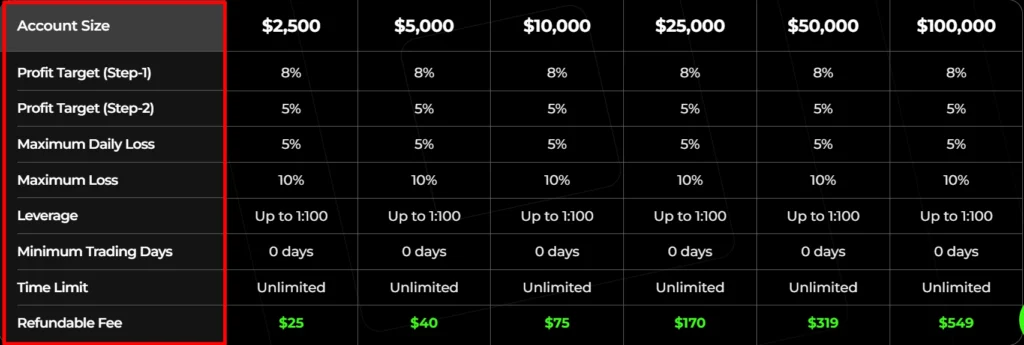Prop trading firms use strict rules like profit targets, max drawdown, and daily loss limits to find disciplined traders and protect their capital—here’s what every rule really means (and how to survive them).
Why Do Prop Firms Have So Many Rules?
Prop firms load up on rules for one simple reason: to protect their money from reckless trading and find real, skilled traders, not just lucky gamblers.
Every rule has a job:
- Profit targets prove you can actually make money, not just survive by accident.
- Drawdown and daily loss limits weed out traders who let losses spiral out of control.
- Minimum trading days (at most firms) force consistency, not one lucky trade.
- News and weekend restrictions keep the firm safe from sudden market moves that can blow up accounts overnight.
- Leverage limits stop traders from swinging for the fences with massive positions and blowing up fast.
Bottom line:
If you can hit the profit target and respect all the risk rules, you’re the kind of trader a real prop firm wants—someone who can be trusted with serious capital, not just another challenge fee.
Key Rules Every Prop Firm Uses (And What They Mean)
| Rule | What It Means | Typical Range | Example (Master Funders) |
| Profit Target | The % return you must hit to pass the challenge | 5–10% per phase | 8% Step 1, 5% Step 2 (Core Challenge) |
| Maximum Drawdown | The biggest loss from peak to trough allowed before you fail | 5–12% | 10% fixed for Core/Lite |
| Daily Loss Limit | Max you can lose in one day | 3–6% | 5% per day (all challenges) |
| Minimum Trading Days | Number of days you must actively trade to pass | 5–10 at most firms | 0—pass in one day if you want |
| News/Weekend Restrictions | Limits on trading during news releases or holding over weekends | Often banned at big firms | Trade news & hold weekends allowed |
| Leverage | How much bigger you can trade vs. your account balance | 1:10–1:500 | 1:100 Core/Lite, 1:500 Speed Challenge |
| Strategies Allowed/Banned | What trading styles/tools are OK (e.g. EAs, grid, hedging) | Some restrict EAs/news | EAs, news trading allowed |
| Scaling Plans | Whether your funded account can grow with good performance | Sometimes offered | Available (see scaling rules) |
TL;DR:
- Profit Target: Hit the required return—usually 5–10%—to pass.
- Drawdown: Keep your losses under control, or you’re out.
- Daily Loss: Don’t blow up in one day—risk management is key.
- Minimum Days: Prove you’re consistent. (Master Funders = pass as fast as you want.)
- News/Weekend: Many firms limit news trading—Master Funders lets you trade anytime.
- Leverage: Higher leverage = bigger trades, bigger risk. Know your numbers.
- Strategy Rules: Always check if bots, hedging, or news trades are allowed.
- Scaling: Trade well, get more capital. Not all firms offer it—Master Funders does.
Rule Deep Dives
Profit Target
Most prop firms set a profit target between 5% and 10%—you need to grow the account by that much to pass each challenge step.
You have to hit the target without breaking any other rules (like drawdown or daily loss).
Master Funders: 8% profit in Step 1, 5% in Step 2 for the Core Challenge. Lite Challenge: 5% in both steps (easier for new traders). Speed Challenge: 10% in 24 hours.
Pro tip: Don’t go all-in on one trade. Consistency is safer than swinging for the fences.
Maximum Drawdown
Drawdown is the biggest loss your account takes from a high point—if you hit the limit, you fail the challenge, even if you’re still above your starting balance.
- Static drawdown: Fixed from your starting balance (e.g., always 10% off your initial capital).
- Trailing drawdown: Moves up as you make profits, so your “safe zone” rises, too.
Most traders fail from ignoring this rule: track your max loss at all times, not just your open trades.
Master Funders: 10% fixed (static) drawdown for Core and Lite Challenges. Easy to track.
Daily Loss Limit
This rule is there to stop you from blowing up in one bad day. Go over the limit—usually 3–6% of your starting balance—and you’re out, even if you’re up for the month.
How to stay safe:
- Use stop losses on every trade.
- Don’t revenge trade or try to “win it back.”
- Know your max risk before you enter.
Common mistake: Making a big loss in the morning and trying to recover all day, just to break the rule by lunchtime.
Minimum Trading Days
Most prop firms force you to trade for a certain number of days—usually 5 to 10—to prove your results aren’t just luck. This slows down fast traders and feels like busywork.
Master Funders: Zero minimum trading days. Pass in one day if you’re good enough—no forced delays.
Real talk:
- Pro: Faster funding for skilled traders.
- Con: If you’re impulsive, you might rush and fail. Trade at your pace.
News and Weekend Restrictions
Big news events and weekend gaps can wreck even the best strategy, so many firms ban trading during news or force you to close before the weekend.
Master Funders:
- Trade during news? Allowed.
- Hold over weekends? Go for it.
- Your risk, your strategy, your call.
Pro tip: This gives you more flexibility, but use a calendar and know when volatility spikes.
Leverage and Allowed Strategies
Leverage lets you trade big with a small balance, but it can magnify losses as much as gains. Most firms offer 1:10 to 1:100; some (like Master Funders Speed Challenge) go up to 1:500.
- Pros: Bigger trades, smaller margin required, more potential profit.
- Risks: Blow up faster if you aren’t careful with risk management.
Can you scalp, use EAs, or hedge?
- Master Funders: Yes to scalping, EAs (Expert Advisors/algos). No ban on news or holding trades.
- Other firms: Some restrict EAs, grid trading, or hedging—always check the fine print.
How to Avoid Failing Your Challenge
Top mistakes that kill most traders’ chances:
- Over-leveraging: Using max lot sizes trying to pass fast—usually ends in disaster.
- Emotional trading: Revenge trading, FOMO, or doubling down after a loss.
- Ignoring the rules: Not reading the fine print—one small mistake can void your whole challenge.
- No stop loss: Hoping trades “come back” instead of cutting losses.
- No trade journal: Not reviewing your mistakes or learning from wins and losses.
Pro tips to pass more challenges:
- Set your max risk per trade before you click “Buy” or “Sell.”
- Use stop losses—no excuses, ever.
- Don’t chase losses or get greedy if you’re close to your profit target.
- Track your progress every day.
- Journal every trade—even a simple note on why you entered and exited can save your account over time.
Where to Learn More or Get Funded
Want rules explained in plain English?
- See all Master Funders Rules
- Check out the Core Challenge
- Browse our Prop Trading Glossary
- Read How Prop Firm Challenges Work
If you’re serious about getting funded, start with a firm that actually wants you to pass—and tells you how to do it. Any questions? Our support team gives real answers.
FAQ: Prop Firm Rules
What happens if I break a rule?
Usually, you fail the challenge instantly—no appeals, no refunds. Every prop firm takes rules seriously, so don’t “test” the system.
Can I get a warning or reset?
Most firms don’t offer warnings—if you break a hard rule, you’re done. Master Funders is unique: use the Second Life Reset (one per month) if you fail Step 2, or a one-time reset in Step 1 if your losses are still small.
Why does Master Funders have no minimum days?
We know real traders can pass in one day if they’re disciplined. Why make you wait five or ten days for no reason? No minimums, no artificial delays.
How do I keep track of my drawdown in real time?
Your prop firm dashboard shows it live. Always check before and after each trade, especially if you’re stacking positions or riding a winning streak.
What if my EA breaks a rule by accident?
You’re still responsible—even if your trading bot/EA triggers a loss or trades during restricted times. Always double-check your settings and test before running a bot live.


